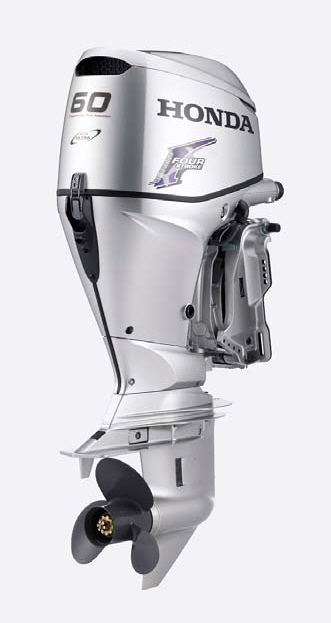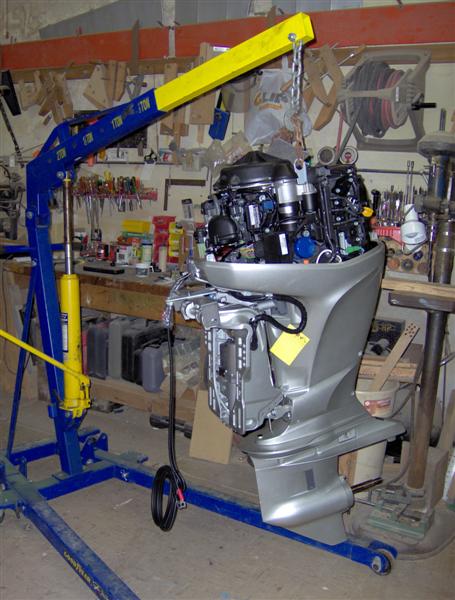
Now that I was nearing the end of construction there was a major decision that needed to be made. The choice of power had been in the back of my mind from the beginning but now required a choice. I had narrowed it down to a short list of three engines, all 60 HP outboards. From the begining I did not intend to push the hull to planing speeds as the purpose of this project was to provide long distance travel with reasonable economy. I was looking for upper end displacement speeds plus a little more when needed. My research indicated that 60 HP would provide performance envelope I sought so I decided to limit the power to that amount.
In the quest for efficiency I also had decided I wanted a fuel injected O/B, plus, I reasoned that a "high thrust", "power thrust" or "Bigfoot" version of the outboards would be a good choice (title differs with manufacturer). For those not familiar with this series of engines I will explain. The 60 HP high thrust units combine a 60 HP powerhead with the lower unit of the 75/90 HP outboard. This provides several advantages in some installations. For example, the lower unit is extremely stout for the horsepower produced. Both the lower unit case and gear set are heavier than the normal 60's. But the main reason I wanted to go that way was the ability to spin a larger diameter prop at a slower RPM. Because the low speeds planned I felt this combination would be more efficient. For example a normal 60 HP Honda outboard swings an 11" prop with a 2.07 gear ratio while the Power Thrust version can use a 14" diameter with a 2.33 gear ratio. And 3" more in diameter represent about a 20% increase in blade area and that is a big difference.
These engines are mainly marketed for pontoon boats. And although pontoons have many virtues efficient performance is usually not one of them. Their relatively inefficient hull designs require more than a fair amount of horsepower to move them at what is often slower speeds than more conventional hulls. Thus the "high thrust" engines were designed to handle these heavier loads. So in my situation with a hull weighing more than 5000 lbs and operating in the 6 to 10 MPH range the idea of a high thrust engine seemed to be a good match.
At the time three manufacturers
produce these outboards - Mercury, Yamaha and Honda. Actually Honda didn't have the 60 power
thrust (or any 60 hp O/B) until late 2009. Until I became aware of it my
choice had been the Yamaha. I just felt it was a more refine and
dependable than the Mercury. But once the Honda came into the mix it
presented a very viable alternative - but not an overwhelming
winner.
In my mind and situation here were the Hondas strong points -
> My experience with Honda 50 on my Cabin Skiff makes me VERY confident in the overall dependability of their engines. Mine has preformed flawlessly for thousands of miles.
> The Honda is the only one of the three O/Bs that will allow the use of a Floscan Fuel Flow meter. Because of the way their fuel injection systems work the Yamaha and Mercury will not. This means I would have to purchase one of their proprietary fuel flow gauges and tachometer (two separate instruments) at a cost of about $1600. The Floscan on the Honda does both for about $300. This was a major consideration for me.
> The Honda has a feature they call "Easy Dock Steering". The engine was designed to allow a full 50 degrees of swing to port and starboard. Other outboards normally max out at about 35 degrees each way. They advertise the result to be much tighter turning radius. I thought this to be a great feature and would allow easier maneuvering in tight quarters.
> The Honda's alternator outputs 27 amps compared 17 amps for the Yamaha and 18 amps for the Mercury. The higher output would be welcome since I was planning to install a "battery combiner" so the O/B would help charge the "house bank" when underway.
> The Honda has a FIVE YEAR warrantee. Others are three.
All the above sounds good but there are a few weaknesses.
> The first is their dealer network. I can't speak for other areas but in the Midwest it is very poor. The number of dealers is low and the quality of some of these is highly questionable. Yes, they all will sell you an engine but many stock no parts or support supplies. Plus looking at some of their shops I wouldn't allow them to work on my bicycle much less my outboard. Fortunately, I can do all of the maintenance work myself and so far that is all that has been required. Plus, almost all parts can be purchased on the Internet. Mercury had a huge dealer network and Yamaha's is very respectable.
> Although they hype the "Easy Dock Steering" it wasn't until after the purchase I discovered there is no way to implement it with Teleflex's BayStar or SeaStar hydraulic steering. Honda said they are working with Teleflex for a fix but to date there is none.
> The Honda was the most expensive of the three.
As to pricing, what I could gather from dealers the Mercury was going to be the least expensive with the Yamaha next. Honda was the most expensive of the three although the total difference wasn't huge. Here I again feel that the small Honda dealer network worked against me. Because there are so few in my area there seemed to be no competition. In fact, the two closest dealers (within 60 miles) one quoted me the flat MSRP and the other came off it slightly. Both said that was there best deal. In order to get what I thought was a decent price I had to drive over 200 miles.
So, with as much information as I could assemble it was time to make the decision. For me price is always important but in this situation not the most important. After weighing all the factors I decided I would once again go with a Honda and the BFP60 Power Thrust was the model chosen. With sweaty palms I wrote the check.
The Honda with the hood removed is hanging form a portable shop crane I was able to borrow from a friend next door. Yes the photo is a little confusing with all the "stuff" in the background.
With the lower unit removed for floor clearance the motor is positioned on the transom extension. The crane made this job easy. I could just mark for the mounting bolts and roll it away. Once drilled it was rolled back in place and bolted.
And here is the finished installation with the side swim platforms in place. The hydraulic steering install was not difficult but bleeding the lines was time consuming. This was some what complicated by the fact I was bleeding the autopilot system at the same time.
UPDATE ADDED 09/29/11 I reached 200 hours on the engine and needed to do the normal scheduled maintenance - oil & filter change, check valves (all 12 of them), new plugs, etc. As I started to assemble the necessary materials I was shocked when it came to buying the spark plugs. The manual calls for and NGK LMAR6C-9. A web search for this plug showed it as a Honda part with a price of $29.60 per plug! I searched in vain for a cross reference to a comparable. In fact, NGKs web site did not even list it. A few web retailers discounted it a little but the best I could find was about $26 per plug - PLUS shipping and handling! I couldn't just bring myself to
pay $30 per without a fight. I called Honda's main USA office and
they explained LMAR6C-9 was custom made for the BF60A/BFP60A
hence the low volume and high price. Still not satisfied I then called
NGK. They said that was true BUT there might be an alternative.
They also make a LMAR6A-9 which is stock # 5946. They
said the specs for this plug is the same as the LMAR6C-9 except the
terminal (top of the plug) is a threaded stud with no nut. On the "C" the
terminal nut (solid slip over post) is built-in. So by just adding a
terminal nut to the "A" version yields the same result as the "C" and is
the correct fit for the cables. For reference - Spark Plug - NGK LMAR6A-9 with terminal nuts added Oil filter - Honda part 15400PFB014 or WIX 51365 or Purolator L14610 (other brands also available)
|

